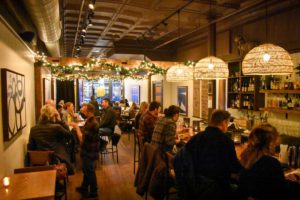Who is a member?
Our members are the local governments of Massachusetts and their elected and appointed leadership.

Pittsfield’s new public relations and marketing campaign highlights the city’s offerings for tourists, including its restaurants and vibrant nightlife. (Photo courtesy city of Pittsfield/Jared Renzi)
In Pittsfield, city leaders are hoping that if you build it — and then get people to blog, Instagram and TikTok about it — people will come.
Using $350,000 of its American Rescue Plan Act funds, Pittsfield has launched a digital public relations and marketing campaign to bring more tourists and visitors, particularly millennials, to the city. The campaign is intended to capitalize on more than a decade of city investments in its arts and culture offerings, and an increasingly vibrant restaurant, nightlife and cultural scene.
Over the summer, the city invited bloggers, writers and influencers to write about the city, and officials said the efforts have paid off: In recent months, content about Pittsfield has generated 131 social media placements and received more than 4.2 million views. Articles and mentions have landed in traditional media outlets including the New York Times, Vogue, and Travel + Leisure.
“When I see a clip from a social media post, and I see people having fun in my city, I am just overjoyed,” said Pittsfield Mayor Linda Tyer.
The city has been working with a consultant, Roger Matus, on its marketing needs and strategy since 2018, including its Love Pittsfield campaign. The city hired a public relations firm, San Francisco-based Bospar, to start working on the campaign in May. During the process, Matus interviewed 23 Pittsfield organizations, including cultural institutions, tourism representatives, recreation facilities and hospitality businesses, to discover what their customers and patrons expect from the city.
“They want active days and lively nights,” Matus told the City Council during a Sept. 13 meeting. “They want a daytime of active outdoors and scenic beauty, and a nighttime of music especially, shows, craft food, craft drink, craft beer. That’s what they’re looking for. And frankly, Pittsfield delivers on all of these things.”
Through his interviews, Matus also discovered that the area’s visitors were becoming younger and more family-oriented. By 2021, 65% of Pittsfield visitors were between the ages of 18 and 44, and the number of families visiting increased by 77% between 2013 and 2021. Given the visitors’ demographics, Tyer said, “we needed to go digital” by focusing on social media.
Over the summer, Bospar set up 10 “familiarization” trips with bloggers, influencers and journalists and gave them suggested itineraries and activities. The firm has also set up another four trips through January. The campaign initially targeted New Yorkers who can take the seasonal weekend Berkshire Flyer Amtrak train up to Pittsfield.
About 15 years ago, when she was a city councilor, Tyer said city officials realized that Pittsfield hadn’t sufficiently tapped into the local arts and culture economy, and started making investments to support live performance centers and an independent movie theater, as well as making streetscape improvements downtown. She said that work continues today. For example, a new brewery coming into the downtown is benefiting from tax increment financing packages approved by the city.
“Those investments were the spark that led us to being the place we are today,” Tyer said.
So far, Pittsfield has spent about 40% of the $350,000 it has set aside for the marketing project, Tyer said. Given the momentum so far, she said it might be beneficial to continue the promotional and marketing campaign into the next fiscal year, but it may depend on other demands on the city’s roughly $41 million in ARPA funding.